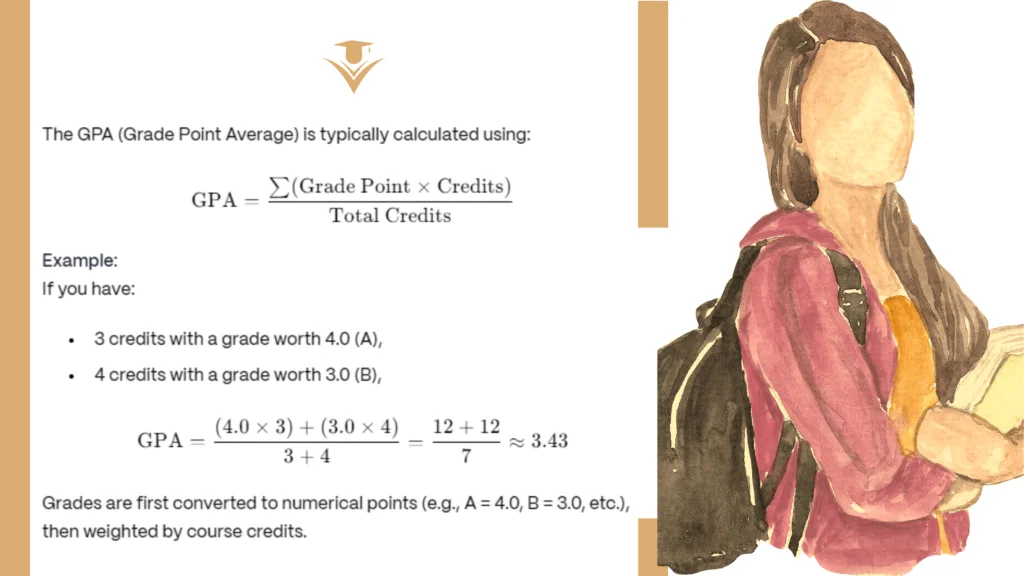What Are Credit Hours and Why They Matter Ultimate Guide (2025)
What Are Credit Hours? A Friendly College Guide
Ever felt like college speaks its own secret language? If you’ve wondered “What are credit hours—and why does everyone keep asking me about them? Why They Matter so much?”, you’re in the right place. As your friendly academic advisor, I’ll translate the jargon and show you how credit hours connect to your schedule, tuition, financial aid, GPA, and—most importantly—graduation.
By the end of this guide, you’ll know what are credit hours exactly how a 3-credit course fits in your week, what “full-time” really means, and how to plan a balanced semester without burning out. We’ll keep things clear, Friendly and a little witty, and totally doable.

College Credit Hours Explained
At its simplest, a credit hour is a way colleges measure academic work. Think of it as the currency of college learning. You earn credit hours by completing courses, and your degree requires a certain total of them.
A common rule of thumb is: 1 credit hour ≈ 1 hour of class time per week in a standard 15-week semester, plus 2–3 hours of study outside class each week. So a 3-credit course often means 3 hours in class and 6–9 hours of study weekly. Across a 15-week term, that adds up to about 45 in-class hours, plus your homework, projects, and exam prep.
Many classes are 3 credits, but not all. Science courses with labs are often 4 credits (3 for lecture + 1 for lab). A lab that’s 1 credit may meet 2–3 hours per week because lab time is hands-on. Seminars, studios, internships, and practicums can be anywhere from 1–6 credits depending on intensity and contact hours.
You’ll also see variations when a school uses accelerated sessions (like 7–8 week terms) or summer sessions. The same total learning is packed into a shorter time frame, so you’ll meet more often each week or complete more online modules to equal the same credit hours.
To make this crystal clear, here’s a quick example. If you take five 3-credit classes in a fall semester, that’s 15 credit hours. Expect about 15 hours in class weekly plus 30–45 hours of study. This is why college is often compared to a full-time job—because at 45–60 total hours per week, it is.
Related terms you’ll also hear (and we’ll weave through this ultimate guide):
-
- How many credit hours is full time
-
- College credit hours explained
-
- Credit hours to graduate
-
- Semester vs quarter credits
-
- What are credit hours cost
-
- Credit hours and GPA
-
- Part-time vs full-time student
Types of courses and typical credit hours:
-
- General education (3–4 credits): Writing, math, science, humanities that build core skills.
-
- Major requirements (3–4 credits): Core courses that define your field of study.
-
- Electives (1–4 credits): Courses you choose to explore interests or deepen expertise.
-
- Lab courses (1–2 credits for the lab portion): Paired with lecture, more hands-on time.
-
- Studios/Practica/Clinicals (1–6 credits): Intensive, skill-based learning.
-
- Seminars/Capstones (1–4 credits): Discussion-heavy or culminating projects.

Semester vs Quarter Credits (and How to Convert)
Most U.S. schools use semesters that last about 15 weeks. Some use quarters (around 10 weeks). The systems award credits differently.
- Typical full-time in semesters: 12–18 credits per term, with many students aiming for 15 credits to stay on a four-year pace.
- Typical full-time in quarters: 12–16 quarter credits per term, with many students taking about 15 quarter credits.
The big conversion tip: 1 semester credit ≈ 1.5 quarter credits. That means 120 semester credits ≈ 180 quarter credits. If you transfer between systems, the registrar converts your credits using this ratio. Always check the official transfer policy at your new school to see how courses map to requirements.
How Credit Hours Affect Tuition, GPA, and Financial Aid
Credit hours aren’t just academic—they impact your tuition, GPA, financial aid, and student status.
To know what are credit hours relation to them, read the following
What are credit hours relation to Tuition and fees
Many colleges bill per credit hour. Others use a block (flat) rate for a range, such as 12–18 credits costing the same. If your school has a flat rate, taking 15 credits often gives you more progress for the same tuition as 12 credits. Keep in mind mandatory fees (technology, student services, lab fees) and course materials.
- Want a primer on how schools price credits and tuition? See your campus bursar/tuition page like this
- For planning total college costs and aid, use federal resources like this
What are credit hours relation to Full-time vs part-time status
Your enrollment status depends on credit hours:
- Undergraduate full-time: usually 12+ credits in a semester.
- Undergraduate half-time: usually 6–11 credits.
- Graduate full-time: commonly 9+ credits (varies by program).
- Overload: usually more than 18 credits; requires permission and may add fees.
Many scholarships and federal aid programs require you to be at least half-time. Some require full-time. International students on F‑1 visas and NCAA athletes also have specific minimums. Always double-check with your registrar or advisor and your financial aid office [Click here].
How many credit hours to graduate
Most degrees set a credit target:
- Associate’s degree: typically 60 credits.
- Bachelor’s degree: typically 120 credits.
- Master’s degree: often 30–36 credits (some specialized programs require more).
These totals vary by institution and program. Within that number, you’ll complete general education, major requirements, and electives. Your catalog year (the rules in effect when you started) governs your exact checklist. Use your degree audit tool to track progress Check this out.
Planning a balanced course load
The sweet spot for many first-year students is 13–15 credits in the first term. It keeps you on pace for graduation while giving bandwidth to adjust to college-level work. Use this simple time estimate:
- Per week: multiply your credits by 2–3 for study time.
- Example: 15 credits ≈ 30–45 hours of study + 15 hours in class = 45–60 hours total.
If you also work a job or commute, consider 12–14 credits while you find your rhythm. You can always catch up with summer or a light overload later (with advisor approval).
What are Credit hours relation to your GPA
Your GPA is credit-weighted, meaning a grade in a 4-credit course influences your GPA more than a grade in a 1-credit course. Each grade equals grade points on a 4.0 scale (A=4.0, A‑=3.7, B+=3.3, etc.). Multiply the grade points by the course credits to get quality points.
How to calculate your GPA (step-by-step):
- List each course with its credit hours and letter grade.
- Convert the letter grade to grade points (e.g., B = 3.0).
- Multiply grade points by course credits to get quality points.
- Add all quality points together.
- Add all attempted credit hours that count toward GPA.
- Divide total quality points by total GPA credits to get your GPA.
Example: Suppose you take four 3‑credit classes and one 4‑credit class (total 16 credits). You earn A (4.0), B+ (3.3), B (3.0), A‑ (3.7), and C+ (2.3) in the 4‑credit course.
- Quality points: 3×4.0=12.0; 3×3.3=9.9; 3×3.0=9.0; 3×3.7=11.1; 4×2.3=9.2.
- Total quality points = 51.2; total credits = 16.
- GPA = 51.2 ÷ 16 = 3.20.

Want to practice with a tool? Try our student-friendly GPA calculator [Click here].
Add/drop, withdrawals, repeats, and Pass/Fail
Policy fine print matters because it changes how credits count.
- Add/Drop period: Early in the term, you can change courses without a grade appearing. Dropped courses typically don’t count as attempted credits.
- Withdrawal (W): After add/drop, withdrawing leaves a W on your transcript. It usually does not affect GPA, but it does count as attempted credits for financial aid pace calculations.
- Repeat policy: Some schools replace a prior grade when you repeat a course; others average them. This changes your GPA math—check your catalog.
- Pass/Fail (P/F) or Satisfactory/Unsatisfactory (S/U): A Pass usually earns credits but doesn’t affect GPA. A Fail affects GPA like an F. Some scholarships limit how many P/F credits you can take.
What are credit hours relation to Financial aid and Satisfactory Academic Progress (SAP)
To keep federal aid, you must meet Satisfactory Academic Progress. SAP usually includes:
- Minimum GPA (often 2.0 for undergrad; higher for some programs).
- Pace (completion rate): You must complete a certain percentage of attempted credits (often 67%).
- Maximum time frame: You must finish within a set limit (often 150% of the program’s credits—so 180 credits for a 120-credit program).
If you fall short, you can often file an appeal with a plan for improvement, created with an advisor [Click here].
AP/IB/CLEP, dual enrollment, and transfer credits
Pre-college credit can speed your progress.
- AP/IB/CLEP: High scores may earn credit hours or placement. Credit hours post to your transcript but usually don’t affect GPA because there’s no letter grade. Policies vary by school and subject [Example].
- Dual enrollment: College courses taken in high school often transfer as regular credits with grades.
- Transfer credits: When moving schools, courses are evaluated for equivalency. Approved courses count toward total credits and requirements; grades may or may not transfer into your GPA depending on the institution.
Choosing a major and mapping credit hours
Your choice of major shapes which requirements fill your 120 credits, but the math stays manageable if you plan early. Use a four-year plan template to map major courses, general education, and electives term-by-term. If you’re undecided, start with foundational requirements that keep multiple pathways open [Check This Out]. If you’re switching majors, meet with an advisor to re-map your plan efficiently [example].
Online, hybrid, and accelerated formats
In online or hybrid classes, credit hours represent the same learning but with different delivery. Instead of classroom “seat time,” you’ll complete modules, discussions, and assignments equal to the expected workload. Accelerated terms (like 7‑ or 8‑week sessions) condense the schedule, so time management becomes even more critical. Plan daily study blocks to match the rigor.
Time management: build a realistic week
Let’s say you register for 14 credits:
- Two 3‑credit courses, one 4‑credit course with lab, and two 2‑credit electives.
- Expect about 14 class hours plus 28–42 study hours weekly.
- Sketch a weekly calendar that includes sleep, meals, commute, work, clubs, and study blocks. If your total exceeds ~55 hours, consider trimming one elective.
When to take an overload
An overload (usually 19+ credits) can help you graduate early or catch up. But it increases workload fast. Only take an overload if:
- You’ve thrived with 15–16 credits.
- Your schedule has room for 55–65 hours of academics weekly.
- You’ve discussed it with an advisor and checked overload fees and permission rules [Example For University Policy].
Frequently Asked Questions
What are credit hours in college?
A credit hour measures academic work. In many semester systems, 1 credit correlates to about 1 hour of class per week plus 2–3 hours of study. A 3-credit course typically means 3 weekly class hours and 6–9 hours of study for about 15 weeks.
How many credit hours is full time?
For undergraduates, 12+ credits per semester is commonly full-time. For graduate students, 9+ credits is often full-time. Some programs set different thresholds, and certain scholarships or visas have specific requirements, so always confirm with your registrar or financial aid office.
How many credit hours do you need to graduate?
Typical targets are 60 credits for an associate’s degree and 120 credits for a bachelor’s degree. Master’s programs often require 30–36 credits. Your exact number depends on the program and catalog year—check your degree audit and talk with an advisor.
You’ve Got This: Mastering Your Credit Hours
The biggest takeaway is simple: credit hours are your academic roadmap. They tell you how much time a class will take, how your tuition is calculated, how your GPA is weighted, whether your financial aid stays intact, and how many steps remain until you cross the stage at graduation.
Map your semesters with intention, aim for a balanced load, and use tools like your degree audit, advisor appointments, and a weekly study plan. If you remember nothing else, remember this: a steady 13–15 credits per term, plus smart time management, keeps you on track. You’ve got the focus—and now you’ve got the framework.
Ready to plan your next semester? Open your degree audit, list your remaining requirements, and sketch a schedule that fits your life. If you ever feel stuck, reach out for help. I’m rooting for you, and your future self will thank you for mastering the basics—starting with understanding what are credit hours.
Author Bio:
Written by Dr. Maya Thompson (2025), M.Ed., Senior Academic Advisor with 15+ years of experience guiding first-year and transfer students at large public and private universities. Maya is a NACADA member, former registrar’s office policy analyst, and the creator of multiple first-year success seminars on time management and degree planning. She’s helped thousands of students decode credit hours, optimize course loads, and graduate on time with confidence. When she’s not advising, she guest lectures on student success and contributes to college readiness workshops for local high schools.

Good on ya for this ripper content! Made my day.
авто mailsco.online высокий уровень удобства и защиты.
игры https://mailsco.online/ веселье помогают формированию логического осознания, оптимизируют способности коммуникации.
Мастер на час в Москве цены на услуги рекомендую
Муж на час в москве цены на услуги и ремонт, расценки мастера на час Здесь…
https://onhour.ru
onhour.ru
https://www.fanforum.com/redirect-to/?redirect=https://onhour.ru
Мастер на час Москва вызвать рекомендую
Муж на час в москве цены на услуги и ремонт, расценки мастера на час More info…
https://onhour.ru
onhour.ru
https://www.fanforum.com/redirect-to/?redirect=https://onhour.ru
yydfhgwxkjsujdyuyyvynnrvdxhojx
Муж на час официальный сайт !..
Муж на час в москве цены на услуги и ремонт, расценки мастера на час Show more!
https://onhour.ru
onhour.ru
https://www.fanforum.com/redirect-to/?redirect=https://onhour.ru
https://newvision4lasvegas.com/x/cdn/?https://onhour.ru
http://clients1.google.co.ck/url?q=https://onhour.ru
http://Privatelink.De/?https://onhour.ru
https://cpinspectionsco.com/x/cdn/?https://onhour.ru
https://www.google.gr/url?q=https://onhour.ru
https://maps.google.hr/url?q=https://onhour.ru
Муж на час в Москве телефон сайт
Муж на час в москве цены на услуги и ремонт, расценки мастера на час Здесь!
https://onhour.ru
onhour.ru
https://www.fanforum.com/redirect-to/?redirect=https://onhour.ru
https://newvision4lasvegas.com/x/cdn/?https://onhour.ru
http://clients1.google.co.ck/url?q=https://onhour.ru
http://Privatelink.De/?https://onhour.ru
https://cpinspectionsco.com/x/cdn/?https://onhour.ru
https://www.google.gr/url?q=https://onhour.ru
https://maps.google.hr/url?q=https://onhour.ru
токарный чпу цена http://www.gdestanok.ru/ – https://gdestanok.ru/